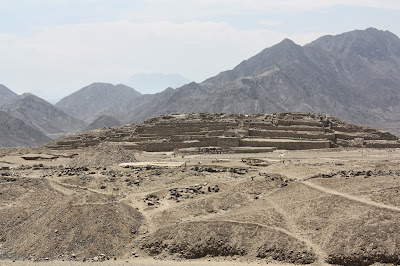 |
| One of Caral Temple |
There is evidence of trade throughout Caral, there are remnants of fish; anchovies and sardines from the coast that is 32 km away. It appears to have been a good reciprocal trade from the coast, as Caral's crops consisted of cotton which was made into fishing nets. Crops also consisted of beans, squash, sweet potato, gourds, achira (queensland arrowroot), and guayaba fruit. There was an irrigation system from the river to the crops, the land in Supe is very fertile when water is available. Caral appeared to be a place where people enjoyed themselves, there is an amphitheater where many carved bone flutes were found, there was traces of a plant that was probably used as aphrodisiacs. Hallucinogenics were found inside shells and could have been used during religious ceremonies, other drugs like coka plants, and lime plant which was inhaled as a substance. The only remains human remains found inside Caral was of a two month old baby, that was placed in a fetal position covered in fine cloth and beads which presumably came from a necklace or jewelry. Another important find was a primitive looking khipu (quipu) which invalidates the suggestion that Wari culture created khipu's, this is especially significant because it means that it is one of the earliest forms or writing and record keeping.
Archaeologists have estimated that people inhabited Caral for around 1000 years, it was remodeled multiple times over this period. There are six temples which are all unique unto each other, with size, orientation and layout. This was probably to distinguish the temples to the residents and visitors. The temples are made earthquake resistant by having groups of the interior stones in nets, so movement could occur but would not dislodge the whole temple. Near one of the temples, is a walled plaza with a sunken amphitheater, with elevated grounds around it. This is suggested to be symbolizing the mother east and the father apu, or some other balance in their world. Near the amphitheater (29 m in diameter) is a fire alter where religious ceremonies could have been centralized.
 |
| Vegetation around the river (view from near a temple) |
No comments:
Post a Comment